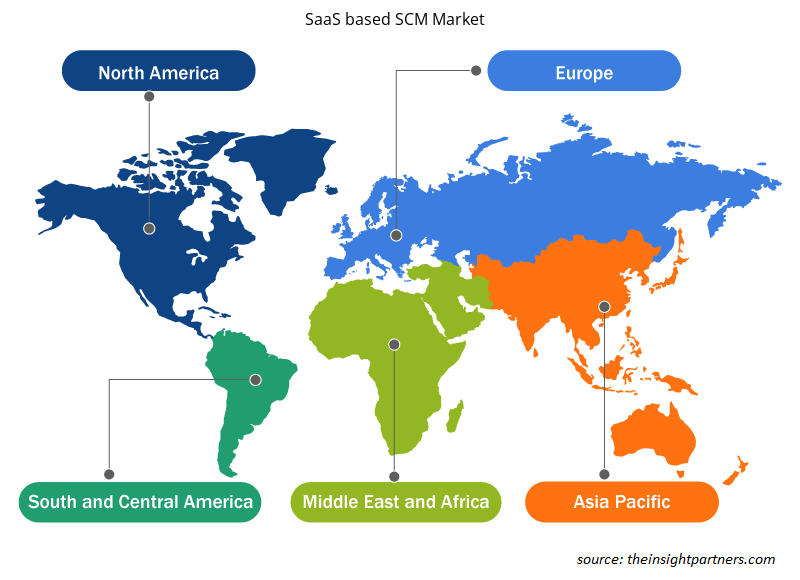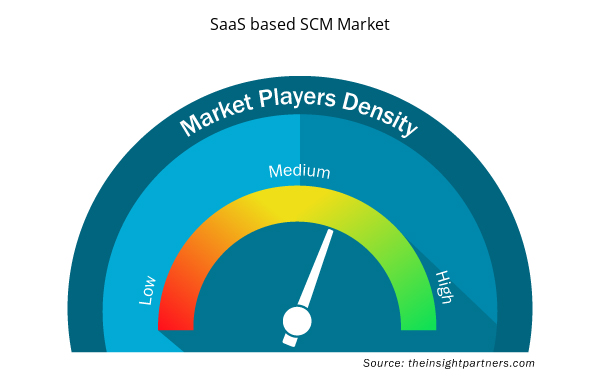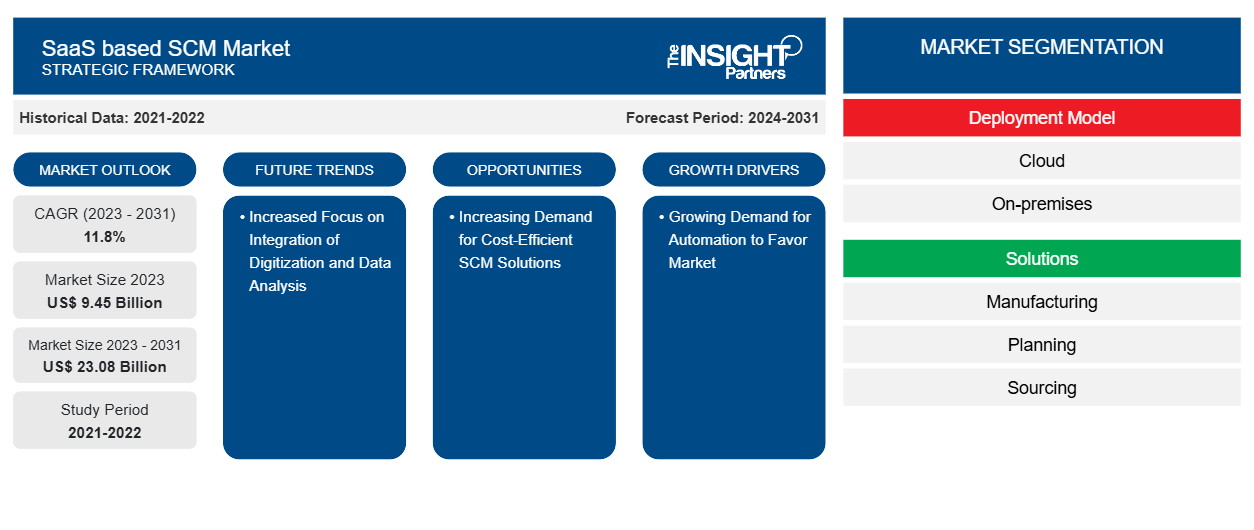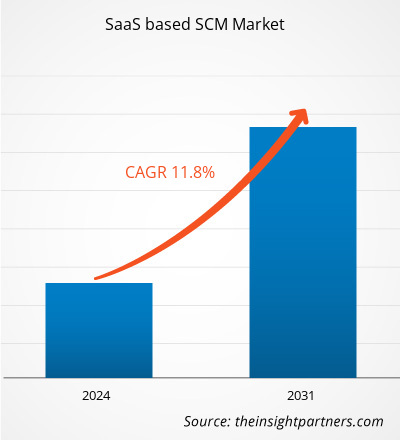SaaS ベースの SCM 市場規模は、2023 年の 94.5 億米ドルから 2031 年には 230.8 億米ドルに達すると予測されています。市場は 2023 年から 2031 年にかけて 11.8% の CAGR を記録すると予想されています。SCM の自動化に対する需要の増加とサプライ チェーンの可視性に対するニーズの高まりは、ますます重要になっています。
SaaS ベースの SCM 市場分析
SaaS ベースの SCM 市場は、技術の進歩、効率的で費用対効果の高い SCM ソリューションに対するニーズの高まり、クラウド サービスの需要の増加、中小企業数の増加、サプライ チェーンの可視性、顧客サービスの向上、コスト削減のための統合 SCM ソリューションのニーズにより、急速に成長すると予想されています。
SaaS ベースの SCM 市場の概要
SaaS (サービスとしてのソフトウェア) サプライ チェーン管理 (SCM) ソフトウェアは、企業がサプライ チェーン全体を管理するのに役立つクラウド ベースのソフトウェア ソリューションです。SaaS SCM ソフトウェアは、従来の方法に比べて使いやすく、拡張性が高く、手頃な価格であるため、あらゆる規模の企業に人気のある選択肢と考えられています。
要件に合わせてレポートをカスタマイズする
このレポートの一部、国レベルの分析、Excelデータパックなど、あらゆるレポートを無料でカスタマイズできます。また、スタートアップや大学向けのお得なオファーや割引もご利用いただけます。
- このレポートの主要な市場動向を入手してください。この無料サンプルには、市場動向から見積もりや予測に至るまでのデータ分析が含まれます。
SaaS ベースの SCM 市場の推進要因と機会
自動化の需要増加が市場を有利に導く
自動化は手作業を減らして効率を高めることができるため、サプライ チェーン管理(SCM) 業界で人気が高まっています。組織は自動化によって経費を削減し、精度を高めることで業務を最大化できます。さらに、自動化により、サプライ チェーン プロセスを柔軟かつスケーラブルに管理できるため、変化する市場状況や顧客の期待に企業が迅速に適応できるようになります。
コスト効率の高いSCMソリューションに対する需要の増加
統合サプライ チェーン管理ソリューションに対する需要の高まりは、予測期間中に SaaS ベースの SCM 市場の成長を促進すると予想されます。市場の主な推進力は、手頃な価格で柔軟性があり、効果的なサプライ チェーン管理システムに対する需要の高まりです。市場の拡大を推進するもう 1 つの重要な側面は、手頃な価格のサプライ チェーン管理システムに対する需要の高まりです。市場のもう 1 つの重要な推進力は、統合された完全なサプライ チェーン管理ソリューションに対する需要の高まりです。市場は、サプライ チェーン管理コストを削減し、より効果的な運用を促進すると予想されるクラウドベースのテクノロジーとサービスに対する需要の高まりによっても推進されています。
SaaS ベースの SCM 市場レポートのセグメンテーション分析
SaaS ベースの SCM 市場分析の導出に貢献した主要なセグメントは、展開モデル、ソリューション、業界垂直、およびエンドユーザーです。
- 展開モデルに基づいて、SaaS ベースの SCM 市場はクラウドとオンプレミスに分けられます。
- ソリューション別に見ると、市場は製造と計画、調達と購買、サプライチェーン計画、倉庫管理、輸送管理、その他に分類されます。
- 業界別では、SaaS ベースの SCM 市場は、輸送および物流サービス、製造、小売、公共部門、流通ネットワークに分かれています。
- エンドユーザーの観点から見ると、市場は中小企業と大企業に分かれています。
SaaS ベースの SCM 市場シェア分析 (地域別)
SaaS ベースの SCM 市場レポートの地理的範囲は、主に北米、アジア太平洋、ヨーロッパ、中東およびアフリカ、南米/中南米の 5 つの地域に分かれています。北米は SaaS ベースの SCM 市場を支配してきました。北米地域のさまざまな業界でのハイテク採用の傾向が、SaaS ベースの SCM 市場の成長を後押ししています。デジタル技術の採用の増加や政府機関による多額の技術支出などの要因が、北米の SaaS ベースの SCM 市場の成長を牽引すると予想されています。さらに、米国とカナダの先進国では研究開発に重点が置かれているため、北米のプレーヤーは技術的に高度なソリューションを市場に投入せざるを得ません。さらに、米国には多数の SaaS ベースの SCM 市場プレーヤーがおり、革新的なソリューションの開発にますます重点を置いています。これらすべての要因が、この地域の SaaS ベースの SCM 市場の成長に貢献しています。
SaaS ベースの SCM 市場の地域別分析
予測期間を通じて SaaS ベースの SCM 市場に影響を与える地域的な傾向と要因は、Insight Partners のアナリストによって徹底的に説明されています。このセクションでは、北米、ヨーロッパ、アジア太平洋、中東およびアフリカ、南米および中米にわたる SaaS ベースの SCM 市場のセグメントと地理についても説明します。

- SaaSベースのSCM市場の地域別データを入手
SaaSベースのSCM市場レポートの範囲
| レポート属性 | 詳細 |
|---|---|
| 2023年の市場規模 | 94.5億米ドル |
| 2031年までの市場規模 | 230.8億米ドル |
| 世界のCAGR(2023年~2031年) | 11.8% |
| 履歴データ | 2021-2022 |
| 予測期間 | 2024-2031 |
| 対象セグメント | 導入モデル別
|
| 対象地域と国 | 北米
|
| 市場リーダーと主要企業プロフィール |
|
SaaS ベースの SCM 市場プレーヤーの密度: ビジネス ダイナミクスへの影響を理解する
SaaS ベースの SCM 市場は、消費者の嗜好の変化、技術の進歩、製品の利点に対する認識の高まりなどの要因により、エンドユーザーの需要が高まり、急速に成長しています。需要が高まるにつれて、企業は提供内容を拡大し、消費者のニーズを満たすために革新し、新たなトレンドを活用し、市場の成長をさらに促進しています。
市場プレーヤー密度とは、特定の市場または業界内で活動している企業または会社の分布を指します。これは、特定の市場スペースに、その規模または総市場価値と比較して、どれだけの競合相手 (市場プレーヤー) が存在するかを示します。
SaaS ベースの SCM 市場で事業を展開している主要企業は次のとおりです。
- デカルトシステムズグループ株式会社
- インフォア
- クレオ
- 財務諸表
- エピコアソフトウェア株式会社
- オラクル
免責事項:上記の企業は、特定の順序でランク付けされていません。

- SaaSベースのSCM市場のトップキープレーヤーの概要を入手
SaaS ベースの SCM 市場ニュースと最近の動向
SaaS ベースの SCM 市場は、主要な企業出版物、協会データ、データベースなどの一次調査と二次調査後の定性的および定量的データを収集することによって評価されます。以下は、市場の動向の一覧です。
- 2023 年 4 月、サプライ チェーン組織向けの AI を活用した主要な SaaS ソリューションである Inspectorio は、ブランド、小売業者、サプライヤー、工場などのサプライ チェーン管理を支援する世界初の ChatGPT 駆動型生成 AI ツールである Inspectorio CAPA レコメンダーを導入し、サプライ チェーン業界の障壁を打ち破り続けています。
(出典:Inspectorio、プレスリリース、2023年)
- 2023 年 2 月、クラウド セキュリティのリーダー企業の 1 つである Zscaler, Inc. は、SaaS アプリケーション セキュリティ プラットフォームのイノベーターである Canonic Security を買収する意向を発表しました。Canonic のプラットフォームは、組織における SaaS サプライ チェーン攻撃のリスク増大を防ぐように設計されています。クラウドへの大規模な移行により、組織が数百の SaaS プラットフォームを採用する中、ユーザーは IT 部門の許可なく、Atlassian Suite、Microsoft 365、Salesforce、Google Workspace、Slack などの重要な SaaS プラットフォームに数千のサードパーティ アプリケーションやブラウザー拡張機能を接続しています。
(出典:Zscaler, Inc.、プレスリリース、2023年)
SaaS ベースの SCM 市場レポートの対象範囲と成果物
「SaaS ベースの SCM 市場規模と予測 (2021 ~ 2031 年)」レポートでは、以下の分野をカバーする市場の詳細な分析を提供しています。
- 対象範囲に含まれるすべての主要市場セグメントの世界、地域、国レベルでの市場規模と予測
- 市場の動向(推進要因、制約、主要な機会など)
- 今後の主な動向
- 詳細なPEST/ポーターの5つの力とSWOT分析
- 主要な市場動向、主要プレーヤー、規制、最近の市場動向を網羅した世界および地域の市場分析
- 市場集中、ヒートマップ分析、主要プレーヤー、最近の動向を網羅した業界の状況と競争分析
- 詳細な企業プロフィール
- 過去2年間の分析、基準年、CAGRによる予測(7年間)
- PEST分析とSWOT分析
- 市場規模価値/数量 - 世界、地域、国
- 業界と競争環境
- Excel データセット


- Personality Assessment Solution Market
- Glycomics Market
- Architecture Software Market
- Excimer & Femtosecond Ophthalmic Lasers Market
- Medical and Research Grade Collagen Market
- Biopharmaceutical Contract Manufacturing Market
- Real-Time Location Systems Market
- Aquaculture Market
- Mice Model Market
- Industrial Valves Market

Report Coverage
Revenue forecast, Company Analysis, Industry landscape, Growth factors, and Trends

Segment Covered
This text is related
to segments covered.

Regional Scope
North America, Europe, Asia Pacific, Middle East & Africa, South & Central America

Country Scope
This text is related
to country scope.
よくある質問
The global SaaS based SCM market is expected to reach US$ 23.08 billion by 2031.
The key players holding majority shares in the global SaaS based SCM market are THE DESCARTES SYSTEMS GROUP INC, Infor, Cleo, SAP, Epicor Software Corporation, Oracle, Manhattan Associates, IBM, Kinaxis Inc., Blue Yonder, Inc.
Increasing demand for cost efficient SCM solutions, which is anticipated to play a significant role in the global SaaS based SCM market in the coming years.
Increasing demand for automation in SCM and the rising need for supply chain visibility are the major factors that propel the global SaaS based SCM market growth.
The global SaaS based SCM market was estimated to be US$ 9.45 billion in 2023 and is expected to grow at a CAGR of 11.8 % during the forecast period 2024 - 2031.
Trends and growth analysis reports related to Technology, Media and Telecommunications : READ MORE..
The Insight Partners performs research in 4 major stages: Data Collection & Secondary Research, Primary Research, Data Analysis and Data Triangulation & Final Review.
- Data Collection and Secondary Research:
As a market research and consulting firm operating from a decade, we have published and advised several client across the globe. First step for any study will start with an assessment of currently available data and insights from existing reports. Further, historical and current market information is collected from Investor Presentations, Annual Reports, SEC Filings, etc., and other information related to company’s performance and market positioning are gathered from Paid Databases (Factiva, Hoovers, and Reuters) and various other publications available in public domain.
Several associations trade associates, technical forums, institutes, societies and organization are accessed to gain technical as well as market related insights through their publications such as research papers, blogs and press releases related to the studies are referred to get cues about the market. Further, white papers, journals, magazines, and other news articles published in last 3 years are scrutinized and analyzed to understand the current market trends.
- Primary Research:
The primarily interview analysis comprise of data obtained from industry participants interview and answers to survey questions gathered by in-house primary team.
For primary research, interviews are conducted with industry experts/CEOs/Marketing Managers/VPs/Subject Matter Experts from both demand and supply side to get a 360-degree view of the market. The primary team conducts several interviews based on the complexity of the markets to understand the various market trends and dynamics which makes research more credible and precise.
A typical research interview fulfils the following functions:
- Provides first-hand information on the market size, market trends, growth trends, competitive landscape, and outlook
- Validates and strengthens in-house secondary research findings
- Develops the analysis team’s expertise and market understanding
Primary research involves email interactions and telephone interviews for each market, category, segment, and sub-segment across geographies. The participants who typically take part in such a process include, but are not limited to:
- Industry participants: VPs, business development managers, market intelligence managers and national sales managers
- Outside experts: Valuation experts, research analysts and key opinion leaders specializing in the electronics and semiconductor industry.
Below is the breakup of our primary respondents by company, designation, and region:

Once we receive the confirmation from primary research sources or primary respondents, we finalize the base year market estimation and forecast the data as per the macroeconomic and microeconomic factors assessed during data collection.
- Data Analysis:
Once data is validated through both secondary as well as primary respondents, we finalize the market estimations by hypothesis formulation and factor analysis at regional and country level.
- Macro-Economic Factor Analysis:
We analyse macroeconomic indicators such the gross domestic product (GDP), increase in the demand for goods and services across industries, technological advancement, regional economic growth, governmental policies, the influence of COVID-19, PEST analysis, and other aspects. This analysis aids in setting benchmarks for various nations/regions and approximating market splits. Additionally, the general trend of the aforementioned components aid in determining the market's development possibilities.
- Country Level Data:
Various factors that are especially aligned to the country are taken into account to determine the market size for a certain area and country, including the presence of vendors, such as headquarters and offices, the country's GDP, demand patterns, and industry growth. To comprehend the market dynamics for the nation, a number of growth variables, inhibitors, application areas, and current market trends are researched. The aforementioned elements aid in determining the country's overall market's growth potential.
- Company Profile:
The “Table of Contents” is formulated by listing and analyzing more than 25 - 30 companies operating in the market ecosystem across geographies. However, we profile only 10 companies as a standard practice in our syndicate reports. These 10 companies comprise leading, emerging, and regional players. Nonetheless, our analysis is not restricted to the 10 listed companies, we also analyze other companies present in the market to develop a holistic view and understand the prevailing trends. The “Company Profiles” section in the report covers key facts, business description, products & services, financial information, SWOT analysis, and key developments. The financial information presented is extracted from the annual reports and official documents of the publicly listed companies. Upon collecting the information for the sections of respective companies, we verify them via various primary sources and then compile the data in respective company profiles. The company level information helps us in deriving the base number as well as in forecasting the market size.
- Developing Base Number:
Aggregation of sales statistics (2020-2022) and macro-economic factor, and other secondary and primary research insights are utilized to arrive at base number and related market shares for 2022. The data gaps are identified in this step and relevant market data is analyzed, collected from paid primary interviews or databases. On finalizing the base year market size, forecasts are developed on the basis of macro-economic, industry and market growth factors and company level analysis.
- Data Triangulation and Final Review:
The market findings and base year market size calculations are validated from supply as well as demand side. Demand side validations are based on macro-economic factor analysis and benchmarks for respective regions and countries. In case of supply side validations, revenues of major companies are estimated (in case not available) based on industry benchmark, approximate number of employees, product portfolio, and primary interviews revenues are gathered. Further revenue from target product/service segment is assessed to avoid overshooting of market statistics. In case of heavy deviations between supply and demand side values, all thes steps are repeated to achieve synchronization.
We follow an iterative model, wherein we share our research findings with Subject Matter Experts (SME’s) and Key Opinion Leaders (KOLs) until consensus view of the market is not formulated – this model negates any drastic deviation in the opinions of experts. Only validated and universally acceptable research findings are quoted in our reports.
We have important check points that we use to validate our research findings – which we call – data triangulation, where we validate the information, we generate from secondary sources with primary interviews and then we re-validate with our internal data bases and Subject matter experts. This comprehensive model enables us to deliver high quality, reliable data in shortest possible time.


 このレポートの無料サンプルを入手する
このレポートの無料サンプルを入手する